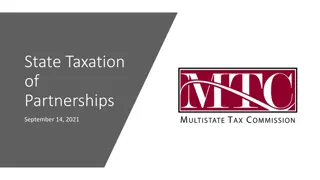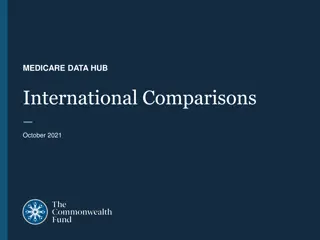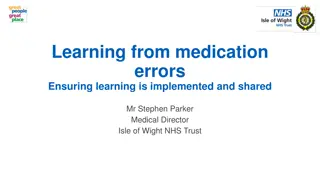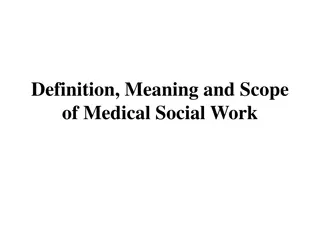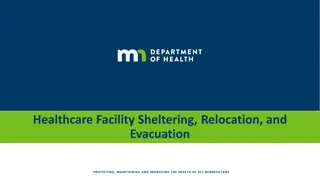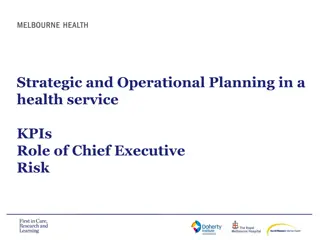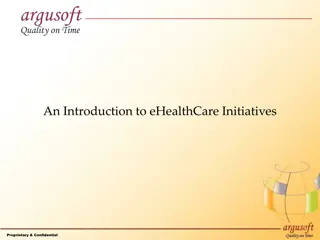Understanding Formulary Systems in Healthcare
A formulary is a dynamic list of medications curated by healthcare professionals to guide drug selection based on efficacy, safety, cost, and patient acceptability. It plays a vital role in promoting evidence-based and cost-effective drug therapy, improving communication between prescribers and pharmacists, and ensuring quality drug use. Various types of formularies exist, such as national, hospital, and local formularies, each serving specific needs. Developing a formulary system benefits healthcare practices by enhancing rational prescribing, optimizing drug inventory management, and fostering seamless care coordination. The optimal number of drugs in a formulary balances coverage of common conditions with efficient and rational drug selection.
Download Presentation

Please find below an Image/Link to download the presentation.
The content on the website is provided AS IS for your information and personal use only. It may not be sold, licensed, or shared on other websites without obtaining consent from the author. Download presentation by click this link. If you encounter any issues during the download, it is possible that the publisher has removed the file from their server.
E N D
Presentation Transcript
Lec Lec 3 3 Formulary systems Formulary systems
Background Background A formulary is a continually updated list of medications and related information, representing the clinical judgement of physicians, pharmacists and other experts in the diagnosis, prophylaxis or treatment of disease and promotion of health.
Selection of drugs for inclusion in a formulary Selection of drugs for inclusion in a formulary Drugs are selected for inclusion on the basis of their: efficacy safety patient acceptability cost.
Types of formularies Types of formularies National formularies (e.g. British National Formulary (BNF)) Hospital formularies Local formularies Joint hospital local formularies. Open formulary system: the formulary recommends drugs and non-formulary drugs are still routinely available Closed formulary system: restricted drug list: only medicines included in the formulary may be used.
Reasons to develop formulary system Reasons to develop formulary system To ensure quality and appropriateness of drug use in a particular practice To teach appropriate drug therapy especially relevant for junior doctors To promote evidence-based and cost effective drug therapy To cut down on the range of drugs in use To encourage the use of therapeutic protocols.
Benefits of a formulary Benefits of a formulary Cost-effective prescribing Rational prescribing Use of a restricted range of drugs results in better knowledge of drug use Better stock management Improvement in communication between prescribers and pharmacists Promotes seamless care between hospital practitioners and primary care practitioners.
Number of drugs to be included in a formulary Number of drugs to be included in a formulary A formulary for general practice should include enough drugs to treat 80 90% of all common conditions met in the practice in addition to emergency drugs. Having too many drugs in a formulary defeats its purpose of cost-reduction, effective and rational selection. Having too few drugs in the formulary makes the formulary an ineffective and useless resource.
Objections to development of a formulary Objections to development of a formulary Deprives the prescribers of the freedom of prescription Allows for purchase of inferior quality drugs Does not always reduce the cost to the consumer.
Formulary management system Formulary management system Has to be flexible and dynamic Regular updates to reflect current practice (e.g. biannual or annual editions) Inclusion of new drugs released on the market: consider issue of safety, cost, indications, me-too drugs Withdrawing drugs: discontinued drugs, drugs no longer prescribed Procedure to meet non-formulary requests.
Inclusion criteria Inclusion criteria Efficacy Side-effect profile and contraindications Interaction profile Pharmacokinetic profile Patient acceptability: taste, appearance, ease of administration Generic availability, cost.
Ethical implications of developing a formulary Ethical implications of developing a formulary system system Interfering with non-pharmacological basis for choice of product Formulary system may provide for generic substitution or therapeutic substitution Interactions with the pharmaceutical industry may influence the formulary system.
Non Non- -pharmacological basis of therapeutics pharmacological basis of therapeutics At the macro level, prescribing trends that influence the individual prescriber include: cost availability of product traditions and education of society (e.g. may influence dosage form selection) health issues stability and power of pharmaceutical industry medical teaching.
At the micro level, the individual prescriber is influenced by: peer groups society control measures and regulations by health authorities pharmaceutical industry.
Therapeutic substitution Therapeutic substitution Opposition to therapeutic substitution is based on three factors: lack of scientific and clinical evidence clinical studies suggesting that not all drugs of similar classes are equivalent holistic approach in drug therapy.
factors influencing inclusion of drugs in a factors influencing inclusion of drugs in a formulary. formulary. Efficacy (e.g. demonstrated in clinical trials) Toxicity (e.g. for equally effective drugs, select the least toxic) Adverse effects (e.g. include drugs with same indication but different side-effect profiles) Contraindications (e.g. avoid drugs with serious teratogenic effects)
Interactions (e.g. select drug with least clinically significant interactions) Pharmacokinetic profile (e.g. include drugs with short half- lives, include drugs minimally affected by hepatic or renal impairment) Formulations available (e.g. drugs available for both oral and parenteral administration allow for smooth transition from parenteral to oral therapy) Generic form available: usually cheaper
Cost: encourage cost-effective prescribing Use (e.g. certain categories of drugs such as anaesthetics may not be relevant to the formulary setting) Type of formulary: specialised or generic Precautions (e.g. avoid drugs that require special storage requirements).



